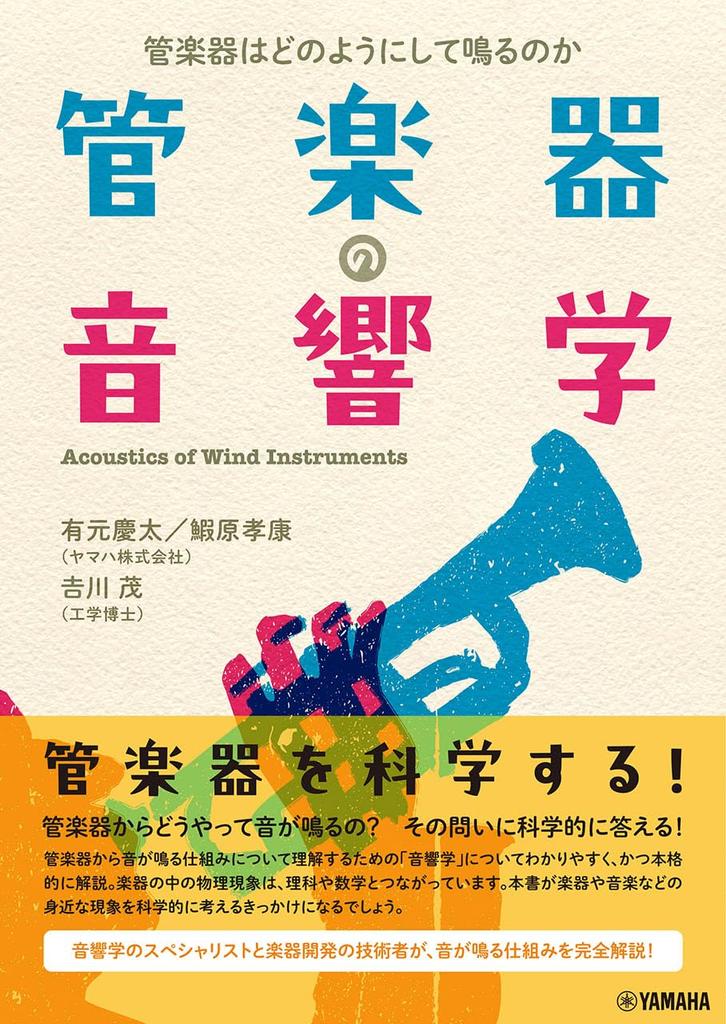A specialized book that thoroughly explains how sound is produced, written by acoustics specialists and musical instrument development engineers.
How do wind instruments produce sound? A scientific answer to that question!
This book provides a clear yet comprehensive explanation of acoustics, helping readers understand how wind instruments produce sound. The physical phenomena within musical instruments are connected to science and mathematics. This book will inspire readers to think scientifically about familiar phenomena such as musical instruments and music.
Contents
Part 1: Reading Material
To make this book accessible even to those without specialized knowledge, the book minimizes mathematical formulas and explains the physical phenomena of wind instruments as clearly as possible, using only diagrams, charts, and text.
Chapter 1: Sound in Pipes: The Foundation for Understanding the Physics of Wind Instruments
Chapter 2: Damping: An Important Physical Phenomenon That Determines the Sound of Wind Instruments
Chapter 3: Self-Excited Vibration: The Principle of How Wind Instruments Produce Sound
Chapter 4: Why Do Wind Instruments Make Sound? What is the Difference Between Woodwind and Brass?
Chapter 5: Air Reed Instruments
Chapter 6: Finger Holes in Woodwind Instruments
Chapter 7: The Function of Tapered Pipes and Bells
Part 2: Main Text
Written as a specialized science and engineering textbook, it makes extensive use of mathematical formulas. However, the chapter structure is the same as the "Readings" section, so reading both will aid in understanding.
Chapter 1: Basic Theory of Vibration and Sound
Chapter 2: Sound Wave Attenuation and Its Mechanism
Chapter 3: Self-Excited Vibration
Chapter 4: The Sounding Mechanism of Reed Woodwind and Brass Instruments
Chapter 5: The Sounding Mechanism of Air Reed Instruments
Chapter 6: On the Finger Holes in Woodwind Instruments
Chapter 7: On Webster's Horn Equation
Author Profile
Shigeru Yoshikawa
Graduated from the Department of Physics, School of Science, Nagoya University in 1974. He then conducted research on the self-excited vibration of organ pipes at Kyushu Institute of Design, Tamagawa University, and Tokyo Institute of Technology. In 1980, he worked at the Defense Agency's Technical Research and Development Institute's Fifth Research Institute. He has conducted research into sonar and underwater acoustics. In 1981, he received the Sato Paper Award from the Acoustical Society of Japan. In 1985, he received his Ph.D. in Engineering (Tokyo Institute of Technology, "Research on Organ Pipes and Their Application to Underwater Sound Sources"). In 1988, he served as a visiting research professor in the School of Science at the U.S. Naval Academy for six months. In 1990, he served as an exchange researcher in the Department of Physical Acoustics at the U.S. Naval Research Laboratory for one year and four months. In 1998, he retired from the Defense Agency and became a professor in the Department of Acoustic Design at Kyushu Institute of Design (now the Faculty of Design, Kyushu University), where he lectured and researched musical instrument acoustics and conducted research on the Sagrada Familia. In 1999, he became a Fellow of the Acoustical Society of America (for his research on wind instruments). In 2015, he retired as a professor in the Department of Acoustics at the Graduate School of Design, Kyushu University, where he remains a professor to this day. His publications include "Does Touch Change the Tone of a Piano? The Physics Behind the Musical Instrument" (Nikkei Science, 1997) and three others. His translations include "The Physics of Musical Instruments" (N.H. Fletcher and T.D. Rossing, translated by Norifumi Kishi, Hidemi Kubota, and Shigeru Yoshikawa, Maruzen Publishing, 2002) and two others. He has also contributed five chapters to four English-language technical books.
Keita Arimoto
Graduated from the Department of Acoustic Design, Faculty of Design, Kyushu Institute of Design, in 2000. He completed his Master's program in Information Communication at Kyushu Institute of Design in 2002. While a student, he researched musical instruments, primarily air reed instruments, in the Musical Instrument Acoustics Laboratory. After joining Yamaha Corporation, he was responsible for research and development in signal processing and music information processing. From 2010 to 2012, he was dispatched by Yamaha Corporation to Pompeu Fabra University (Spain) as a visiting researcher. Since 2017, he has been engaged in research and development in the field of musical instrument acoustics. He is currently conducting research and development that combines his student major in musical instrument acoustics with the signal processing and music information processing technologies he developed after joining Yamaha Corporation.
Takayasu Ebihara
Graduated from the Department of Physics, Faculty of Science, Osaka University in 2010. In 2012, he completed a Master's program in Design at the Kyushu University Graduate School of Design. His research topic was the nonlinearity of hand-stopping playing on the horn. That same year, he joined Yamaha Corporation, where he worked on the development of brass instrument components and the design and development of horns. Since 2020, he has been involved in strategic planning and product planning for educational instruments and wind instrument-related products.
























